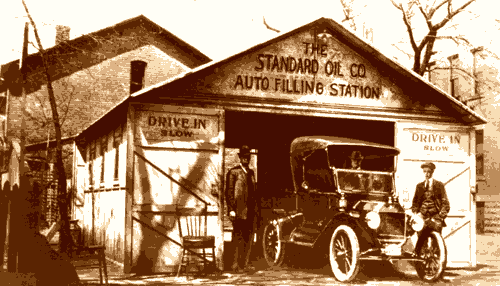


In the above photograph taken in 1912 shows Harvey Wickliffe standing to the left of the auto.
His name was Harvey Wickliffe, but to his friends he was just Wick. He started work for the Standard Oil Company in 1895 as a driver of a tank wagon. These large wagons delivered coal oil to stores within a 20 mile radius of Columbus. During the busy months, his day would start at 5:00 am and not end sometimes until midnight. He remembers keeping his team of horses specially shod for the icy sometimes impassable roads of Central Ohio.
The arrival of the automobile was quite a change for everyone. Those who did not own one of these new machines resented the noise, clouds of dirt, and the fact they frightened the horses. For those that did own a gasoline buggy, the love affair was complete and contagious. Autos began to show up everywhere.
Two Standard Oil men, B.A. Mathews and H.S. Hollingsworth, recognized the opportunity the new horseless carriages were offering. To take advantage of this opportunity, the 2 men created America’s first ever service station.
The business began operations on June 1, 1912, with a portable drive through located on the corner of Oak and Young Streets. This small 14’ x 20’ building was located just 3 blocks east of the State Capital. The manager of this new operation was Mr. Harvey Wickliffe. They called it a “filling station” a name that would endure, even as late as the 1970's.
Customers entered from the front, had their tanks filled by hand-cranked pumps with Standard Red Crown gasoline. Products such as Polarine lubricating oils and other shelf items were also sold.
In his later years, Harvey Wickliffe recalled that there was no electricity in the early days, so for the first few years sales ended at sundown. He also remembered his first free service at the station: offering a grease job with the purchase of 25 cents worth of grease. At times there would be as many as 35 cars waiting in line to be filled. With that kind of success imitation is not far behind. Soon other oil companies opened their own filling stations throughout the city, state and the nation. The rest is as they say, history.